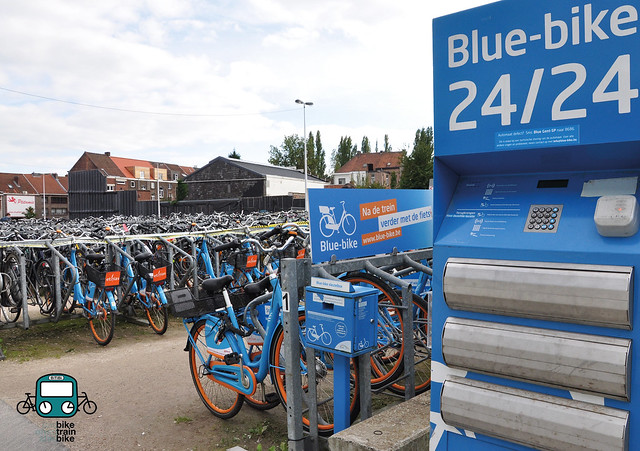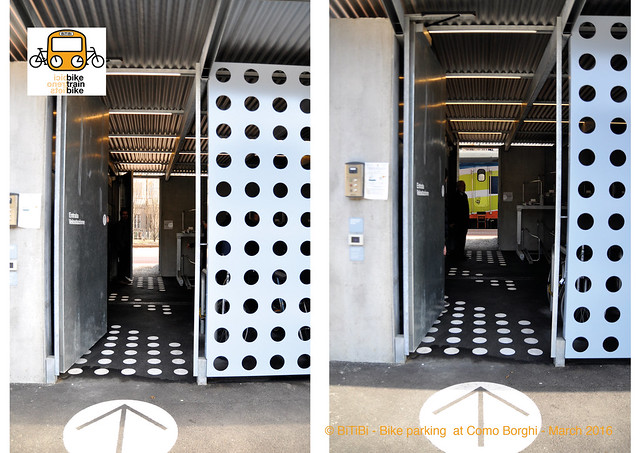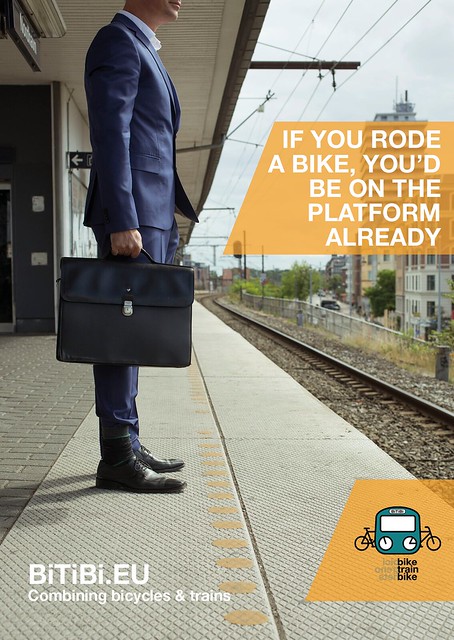
For the past three years, Copenhagenize Design Co., in team with 5 train and bike operators and 4 mobility consulting firms, have been working to develop intermodality between bikes and trains in Europe.
Why this mobility solution makes sense in our cities ?
Because all trips can't be made by bike, this combination is the best solution to compete with cars. Bike-Train-Bike or BiTiBi services combine energy efficient transport modes into one seamless transport service. Indeed, the bicycle is by far the most energy efficient transport for short distances. It allows to increase significantly the catchment areas around train station. The train, especially the low speed train, is the most efficient transport mode for longer distances.


The Dutch approach: bike parking and OV-fiets
With 26% of all daily trips achieved by bike, cycling is an integral part of daily life for everyone in the Netherlands. The country leads the way when it comes to the bike-train-bike combination. This began in the late 1990’s when Dutch train officials noticed old bikes were being parked and left at destination stations by passengers who used them for semi-regular trips. In response, an investment plan to enlarge and renew all cycling facilities at railway stations was passed in 1999. Safe parkings for almost 500,000 bikes are available at train stations and typically has direct connection to the platforms or the station hall. All these facilities make cycling to train stations an easy and attractive option.
By 2002, railway operator NS had already observed a 20% increase in passengers. Today nearly half of all train passengers take a bike to reach their station.

Key to the success of the BiTiBi combination in the Netherlands is OV-fiets. This public bike allows train passengers to reach their final destination by bike after disembarking. Launched in 2003, it is now available at 280 out of 410 stations across the country. These bicycles, in a classic Dutch design, are provided by the main railway operator NS. The same “OV-chipkaart” transit card that is used on trains, buses, metro and trams throughout the country is also used for renting an OV-fiets.

European development in Belgium, Italy, Spain and the United-Kingdom
Based on the Dutch approach, pilot projects were implemented in the regions of Barcelona, Milan, Liverpool and in Belgium. In all countries, projects successfully substituted trips made by cars with bike-train-bike transport. Due to the opening of bike parkings and/or the availability of bikes at stations, more bicycle users have been registered cycling to the stations, and some of them are new train passengers. Some of these bicycle users shifted from cars to this efficient combination due to the improvement of the services.
Here is an summary of the impacts of these services on mobility in the 4 pilot projects:

Positive results in the four European countries
These past years, following the implementation and the improvement of services, and the creation of an appealing communication, positive results have been witnessed in all countries.
In Belgium, the Blue-bike service is now available in 48 train stations over the country. It means that with a same member card, users can rent the same public bike, at the same price and conditions, each time they arrive in one of these 48 cities. In the pilot cities, we calculated than 22% of Blue-bike combined with train trips have replaced a trip formerly made by car.

In northern Italy, the train company Ferrovienord has launched a regional plan and will double the number of secure bike parkings at stations in the coming years. A couple of years ago, Como, a city of Milan area, built a well-designed bike parking for 90 bikes, with direct access on the platform, that should inspire many small and medium sized cities.

In the United-Kingdom, Merseyrail operates the urban railways in the Liverpool area and provides Bike & Go rentals and secured bike shelters. The company developed an attractive communication strategy to make its Bike & Go services visible as soon as train passengers disembark. Moreover, they developed a marketing strategy to facilitate companies to subscribe to the service for their employees and ease daily business trips.
To finish, in Barcelona area, plenty of promotional efforts have been aimed at companies/ The bike operator organised “Try a Bike & Ride to the Station” events and invited several companies to participate.

Building bike parking: 400% rate of return
Considering the basic expense of installing bike parking facilities and the different benefits they provide - mainly due to health benefit and air pollution reduction -, there is a 400% societal return on investment! In other words, society benefits four times as much as the cost of the bike parking facilities.
If this figure does not convince you to invest in bike parking and bike services, a booklet disseminating all the results is available here and the most important data gathered in the pilot projects are available here. For further information, you can also visit the BiTiBi.eu website.
Here is a poster designed by Copenhagenize Design Co to promote BiTiBi.






